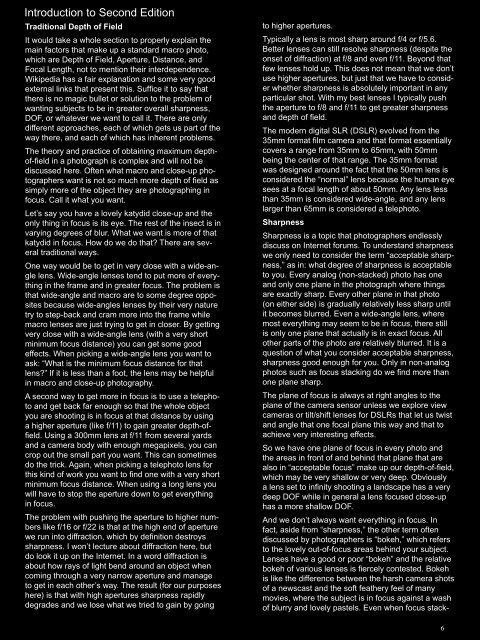The Art of Focus Stacking - Matrix Software
The Art of Focus Stacking - Matrix Software
The Art of Focus Stacking - Matrix Software
You also want an ePaper? Increase the reach of your titles
YUMPU automatically turns print PDFs into web optimized ePapers that Google loves.
Introduction to Second Edition<br />
Traditional Depth <strong>of</strong> Field<br />
It would take a whole section to properly explain the<br />
main factors that make up a standard macro photo,<br />
which are Depth <strong>of</strong> Field, Aperture, Distance, and<br />
Focal Length, not to mention their interdependence.<br />
Wikipedia has a fair explanation and some very good<br />
external links that present this. Suffice it to say that<br />
there is no magic bullet or solution to the problem <strong>of</strong><br />
wanting subjects to be in greater overall sharpness,<br />
DOF, or whatever we want to call it. <strong>The</strong>re are only<br />
different approaches, each <strong>of</strong> which gets us part <strong>of</strong> the<br />
way there, and each <strong>of</strong> which has inherent problems.<br />
<strong>The</strong> theory and practice <strong>of</strong> obtaining maximum depth<strong>of</strong>-field<br />
in a photograph is complex and will not be<br />
discussed here. Often what macro and close-up photographers<br />
want is not so much more depth <strong>of</strong> field as<br />
simply more <strong>of</strong> the object they are photographing in<br />
focus. Call it what you want.<br />
Let’s say you have a lovely katydid close-up and the<br />
only thing in focus is its eye. <strong>The</strong> rest <strong>of</strong> the insect is in<br />
varying degrees <strong>of</strong> blur. What we want is more <strong>of</strong> that<br />
katydid in focus. How do we do that? <strong>The</strong>re are several<br />
traditional ways.<br />
One way would be to get in very close with a wide-angle<br />
lens. Wide-angle lenses tend to put more <strong>of</strong> everything<br />
in the frame and in greater focus. <strong>The</strong> problem is<br />
that wide-angle and macro are to some degree opposites<br />
because wide-angles lenses by their very nature<br />
try to step-back and cram more into the frame while<br />
macro lenses are just trying to get in closer. By getting<br />
very close with a wide-angle lens (with a very short<br />
minimum focus distance) you can get some good<br />
effects. When picking a wide-angle lens you want to<br />
ask: “What is the minimum focus distance for that<br />
lens?” If it is less than a foot, the lens may be helpful<br />
in macro and close-up photography.<br />
A second way to get more in focus is to use a telephoto<br />
and get back far enough so that the whole object<br />
you are shooting is in focus at that distance by using<br />
a higher aperture (like f/11) to gain greater depth-<strong>of</strong>field.<br />
Using a 300mm lens at f/11 from several yards<br />
and a camera body with enough megapixels, you can<br />
crop out the small part you want. This can sometimes<br />
do the trick. Again, when picking a telephoto lens for<br />
this kind <strong>of</strong> work you want to find one with a very short<br />
minimum focus distance. When using a long lens you<br />
will have to stop the aperture down to get everything<br />
in focus.<br />
<strong>The</strong> problem with pushing the aperture to higher numbers<br />
like f/16 or f/22 is that at the high end <strong>of</strong> aperture<br />
we run into diffraction, which by definition destroys<br />
sharpness. I won’t lecture about diffraction here, but<br />
do look it up on the Internet. In a word diffraction is<br />
about how rays <strong>of</strong> light bend around an object when<br />
coming through a very narrow aperture and manage<br />
to get in each other’s way. <strong>The</strong> result (for our purposes<br />
here) is that with high apertures sharpness rapidly<br />
degrades and we lose what we tried to gain by going<br />
to higher apertures.<br />
Typically a lens is most sharp around f/4 or f/5.6.<br />
Better lenses can still resolve sharpness (despite the<br />
onset <strong>of</strong> diffraction) at f/8 and even f/11. Beyond that<br />
few lenses hold up. This does not mean that we don’t<br />
use higher apertures, but just that we have to consider<br />
whether sharpness is absolutely important in any<br />
particular shot. With my best lenses I typically push<br />
the aperture to f/8 and f/11 to get greater sharpness<br />
and depth <strong>of</strong> field.<br />
<strong>The</strong> modern digital SLR (DSLR) evolved from the<br />
35mm format film camera and that format essentially<br />
covers a range from 35mm to 65mm, with 50mm<br />
being the center <strong>of</strong> that range. <strong>The</strong> 35mm format<br />
was designed around the fact that the 50mm lens is<br />
considered the “normal” lens because the human eye<br />
sees at a focal length <strong>of</strong> about 50mm. Any lens less<br />
than 35mm is considered wide-angle, and any lens<br />
larger than 65mm is considered a telephoto.<br />
Sharpness<br />
Sharpness is a topic that photographers endlessly<br />
discuss on Internet forums. To understand sharpness<br />
we only need to consider the term “acceptable sharpness,”<br />
as in: what degree <strong>of</strong> sharpness is acceptable<br />
to you. Every analog (non-stacked) photo has one<br />
and only one plane in the photograph where things<br />
are exactly sharp. Every other plane in that photo<br />
(on either side) is gradually relatively less sharp until<br />
it becomes blurred. Even a wide-angle lens, where<br />
most everything may seem to be in focus, there still<br />
is only one plane that actually is in exact focus. All<br />
other parts <strong>of</strong> the photo are relatively blurred. It is a<br />
question <strong>of</strong> what you consider acceptable sharpness,<br />
sharpness good enough for you. Only in non-analog<br />
photos such as focus stacking do we find more than<br />
one plane sharp.<br />
<strong>The</strong> plane <strong>of</strong> focus is always at right angles to the<br />
plane <strong>of</strong> the camera sensor unless we explore view<br />
cameras or tilt/shift lenses for DSLRs that let us twist<br />
and angle that one focal plane this way and that to<br />
achieve very interesting effects.<br />
So we have one plane <strong>of</strong> focus in every photo and<br />
the areas in front <strong>of</strong> and behind that plane that are<br />
also in “acceptable focus” make up our depth-<strong>of</strong>-field,<br />
which may be very shallow or very deep. Obviously<br />
a lens set to infinity shooting a landscape has a very<br />
deep DOF while in general a lens focused close-up<br />
has a more shallow DOF.<br />
And we don’t always want everything in focus. In<br />
fact, aside from “sharpness,” the other term <strong>of</strong>ten<br />
discussed by photographers is “bokeh,” which refers<br />
to the lovely out-<strong>of</strong>-focus areas behind your subject.<br />
Lenses have a good or poor “bokeh” and the relative<br />
bokeh <strong>of</strong> various lenses is fiercely contested. Bokeh<br />
is like the difference between the harsh camera shots<br />
<strong>of</strong> a newscast and the s<strong>of</strong>t feathery feel <strong>of</strong> many<br />
movies, where the subject is in focus against a wash<br />
<strong>of</strong> blurry and lovely pastels. Even when focus stack-<br />
6

















